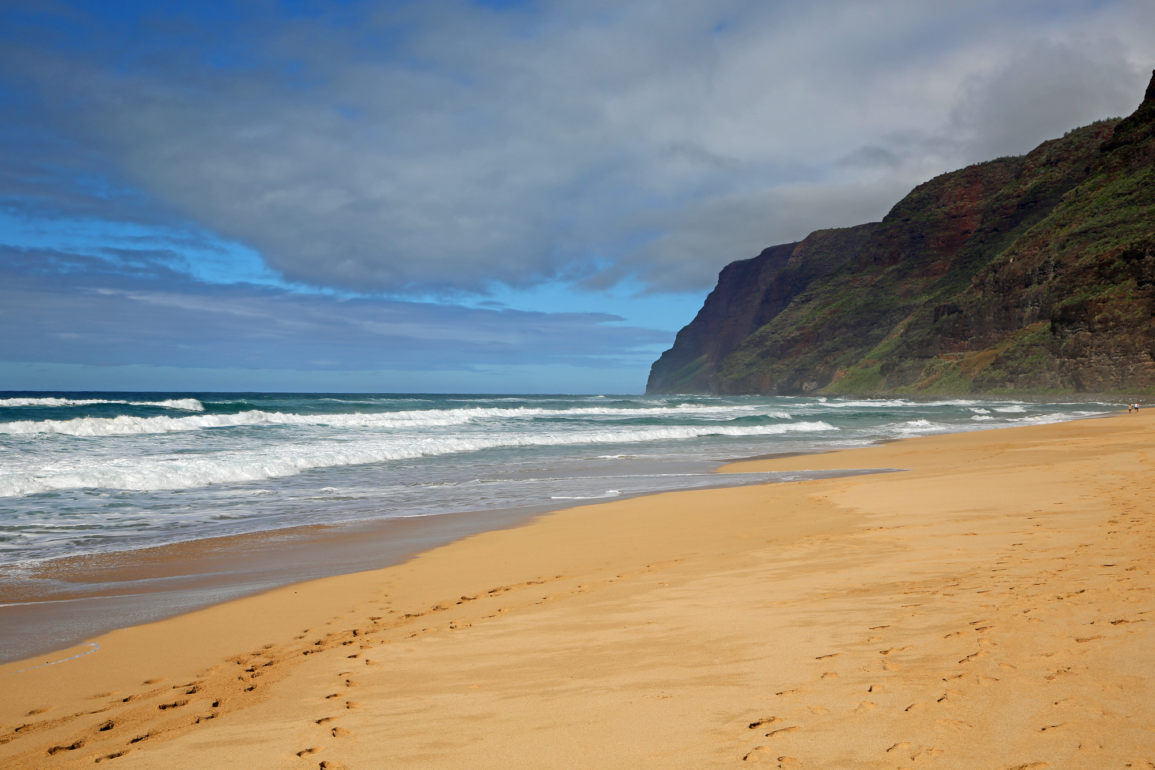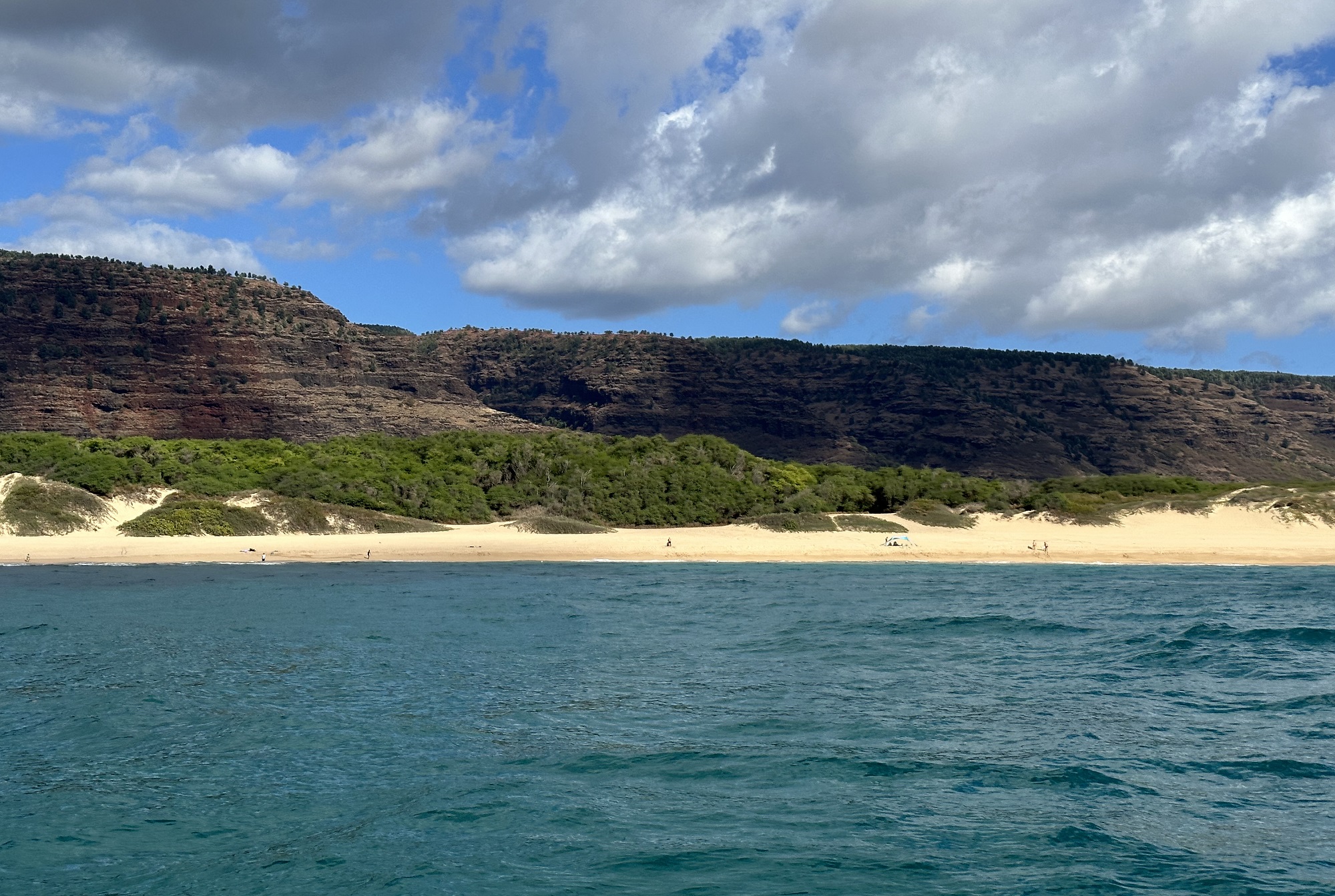- Region: West Shore
- Best for sunbathing, beachcombing, picnicking, camping, fishing, surfing, stargazing and hanging out.
- One of the most secluded beaches on Kauai.
- Not easy to reach due to 5-mile rutted dirt road.
- No lifeguards
- Restrooms, showers and covered picnic tables
- Hours: 5:30 am – 6:45 pm daily
- Camping: By permit only (Reserve Now)
- Map: Google Maps
What sets Polihale Beach apart from other beaches on the island of Kauai is its sheer size, natural beauty and seclusion. It is the longest and widest beach in the Hawaiian Islands. The expansive beach stretches for 17 miles on the western side of Kauai, with the main, most-visited section at 3-miles long. Towering sand dunes, some up to 100 feet high, back the beach against basalt sea cliffs. The broad beach reaches 300 feet wide, except where it tapers to an end at the Na Pali Coast. It is widest in the summer months, and loses about half its width in the winter months.
In addition to its size, Polihale Beach is also known for its seclusion. It is one of the hardest beaches for visitors to reach on Kauai, accessible only by a frustrating and pot-holed 5-mile-long dirt road that is off limits to rental vehicles. Hiking to the beach is not recommended due to the heat and sun on this west side of the island. The beach is easier to reach for local residents with four-wheel-drive vehicles.
But seclusion does have its many rewards. Visitors who brave the rutted road are rewarded with a stunning and sweeping beach with a breathtaking view of the Pacific Ocean and the island of Niihau, and a sense of isolation that is hard to find on other beaches on Kauai. Away from more developed parts of the island, the beach has a wild character where some local residents like to ride on the sand in their 4-wheel-drive vehicles. During the COVID pandemic, the beach was a popular refuge for local residents to escape the island’s restrictive COVID mandates.
Visitors to Polihale Beach appreciate the miles of pristine white sand, the glimmering blue ocean water, the epic sea cliffs, the solitude and isolation, and the extraordinary dark skies that are a rare opportunity for stargazing. For many local residents, Polihale recalls fond memories of family gatherings with fishing, swimming, diving, surfing and camping on this untamed stretch of beach.
Polihale Beach is also an important cultural and historical place for Hawaiians. The Polihale Heiau, a temple dedicated to the dead located in a gully at the north end of the beach, is one of the oldest and most sacred on the island. The beach was an important burial ground for ancient Hawaiians who saw the setting sun on the west end as a metaphor for the end of life. Pahapaha seaweed, a unique plant noted for growing offshore at Polihale, is used by Hawaiians for wreath-making. The seaweed possesses the special quality of reviving to its original freshness when soaked in water.
Activities
Swimming is possible when the water is calm in the summer months, but when the surf is high there are strong rip currents along the length of the beach. In the summer there is a section on the south end of the beach called Queen’s Pond with a sandy bottom and protective reef that is often more suitable for swimming than other parts of the beach. Overall though, with the possibility of dangerous conditions, it’s better to be on the beach than in the water at Polihale.
Camping is a popular activity at Polihale with beachfront tent camping opportunities available daily. For campers, sunsets are stunning at Polihale and nighttime stargazing is spectacular on this dark beach away from city lights. At the time of this writing, camping fees are:
- Hawaii Residents: $20 per campsite per night for up to 10 persons.
- Non-residents: $30 per campsite per night for up to 10 persons.
- Children two and under free.
Campers are reminded by the Hawaii Department of Land and Natural Resources (DLNR) that the road leading to the park is an unimproved dirt road that may flood during rains and become impassable, and other areas may have deep sand. Four-wheel drive vehicles are recommended and rental car companies may prohibit use of their vehicles on the park access road. Stay on designated roads only – NO DRIVING WITHIN DUNES OR ON BEACH, warns the DNLR.
Other activities at Polihale include fishing, surfing and snorkeling, though these activities are predicated on water conditions.
Directions
To visit Polihale Beach you will need a four-wheel-drive vehicle for the five-mile drive on the above-mentioned problematic road (though more than a few attempt the drive in two-wheel-drive vehicles, sometimes with disastrous results). The road is called Lower Saki Mana Road and the entrance is off of Kiko Road near the Barking Sands military installation (location at Google Maps).
What to Bring
Hotter than other parts of the island, and with no natural shade, visitors are advised to bring umbrellas, tents and awnings for protection against the heat and sun, and other provisions including food and plenty of water. Slippers (flip flops) are also recommended as the sand can be too hot for some to walk on.
Final Thoughts
Polihale Beach is a hidden gem on the island of Kauai, and a must-visit spot for anyone looking to escape the crowds and immerse themselves in Kauai’s natural beauty. While the journey to get there may be a bit challenging, the reward of experiencing one of the most stunning and secluded beaches in Hawaii makes it all worthwhile. Whether you’re a beach lover, a camper, or simply looking to relax and soak up the sun, Polihale Beach is a destination you won’t soon forget.




